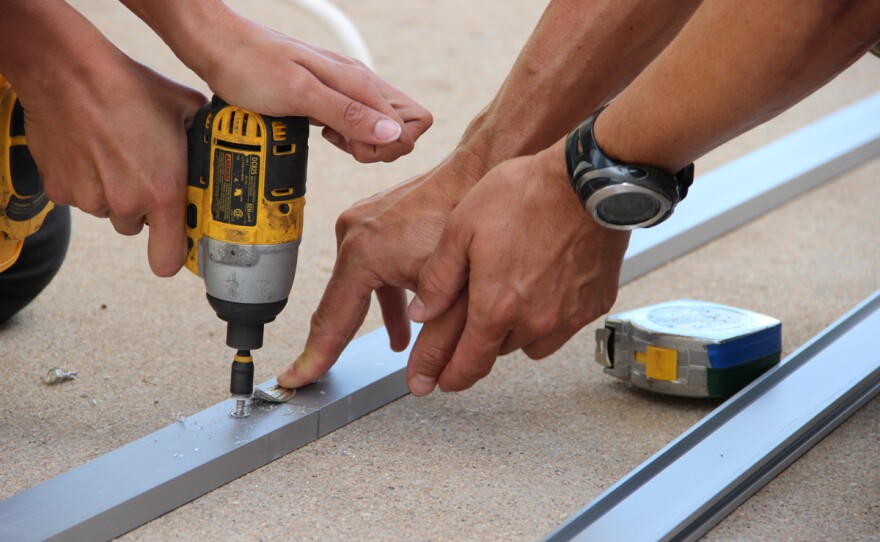In southwest Denver, just blocks off a stretch of West Evans Avenue liberally dotted with auto repair shops and paint stores, a ladder stretches up the side of a small, one-story tan house. Workers atop the roof wield tape measures and oil crayons, calling off numbers and making marks outlining a setup for solar panels.
The house belongs to Erika Caraveo, a short, soft-spoken woman who offers child care services as her main means of income. Normally, Caraveo couldn't afford the cost of a solar installation.
"I'm the only one paying the bills. I'm a single mom," she said.
These solar panels are coming courtesy of a nonprofit and licensed solar contractor called , whose mission involves making renewable power accessible for low-income families.
"We really believe that a transition to a clean energy economy should include everyone," said Shirley Moore, program manager at the Denver office.
After getting their start in California, Grid Alternatives expanded to Colorado in January 2013. It has since opened offices in New York, New Jersey, and Connecticut. In 2014, the nonprofit expanded its Colorado efforts and is on track to complete 50 installations. Next, it hopes to move north into Fort Collins and add locations in Loveland and Boulder.
As Moore explains, everyone in Colorado with a utility bill pays for the state's renewable energy program, which offers rebates and solar connectivity. But low-income families rarely have the cash to afford their own panels.
"So we want to make sure they get what they are paying for."
Additionally, low-income homes are often clustered in locations where the negative impacts of fossil fuel development are higher, places like Commerce City and , with refineries and factories, and the air pollution that comes with them.
"We want to make sure that the people who are most impacted by the things that are causing climate change have an opportunity to be part of the solution," said Moore.
Homeowners who meet the income qualifications add in sweat equity, maybe by helping with construction or cooking lunches for the install team, and pay a small amount over time for the solar panels.
The savings they get from the panels can make a big difference, said Moore.
"If you are low income, utility bills often are a greater percent of your budget," she said.
That potential to shrink her electric costs was what caught Caraveo's eye, when she saw a flier about the program.

"I'm not sure how much I'm going to save, but right now [my bill is] around $100 each month," she said – that includes gas, which is bundled with her electricity.
Caraveo's neighborhood does not have many solar panels, but she does know of a relative who has some, she said. Her children, ages 7 and 9, did not know what they were, but she took them to go see panels on another house. "After that, they were like, cool," she said.
Volunteers Learn Solar Skills
Atop the house, Grid Alternatives volunteer Ken Weisbrod is puzzling through the house's roof layout.
"The next order of business is going to be taking a hammer and figuring out where our rafters are," he tells his team of three workers. They pound a hammer, listening for the thump of a rafter – sort of like finding a stud, the old-fashioned way, he said.
Weisbrod works in the renewable business, and is leading the team on this roof. Grid Alternatives primarily uses volunteers for its installations; many of them are hoping to gain more experience in the solar industry, or are taking community college courses to become certified installers. The job training these volunteers get is another part of the nonprofit's overall goals, Moore explained.
After hammering and measuring, Weisbrod realizes the rafters, on which the solar panel rails will be mounted, are not evenly spaced -- the house is an older one, with some irregularities.

"This will create some challenges for us," he tells the other workers on the roof. But they'll figure it out, he reassures them – it will just take extra time.
Howard Brooks directs the Energy Resource Center, a nonprofit that makes houses more energy efficient. He has partnered with Grid Alternatives on some low-income houses, and says he thinks their work is "starting to take off here."
While his energy efficiency group has been around a long time, since 1979, "the renewable piece of this is starting to catch on," said Brooks.
Inside her house, Caraveo prepares lunch, while a group of children play. She said it was easy to sign up for the program; she just had to fill out some paperwork and go through an orientation with Grid Alternatives.
When asked if she would recommend the program to others, she said she already has. She gestured to another small house across the street, similar to her own.
"I told my dad, he lives right here," she said.








